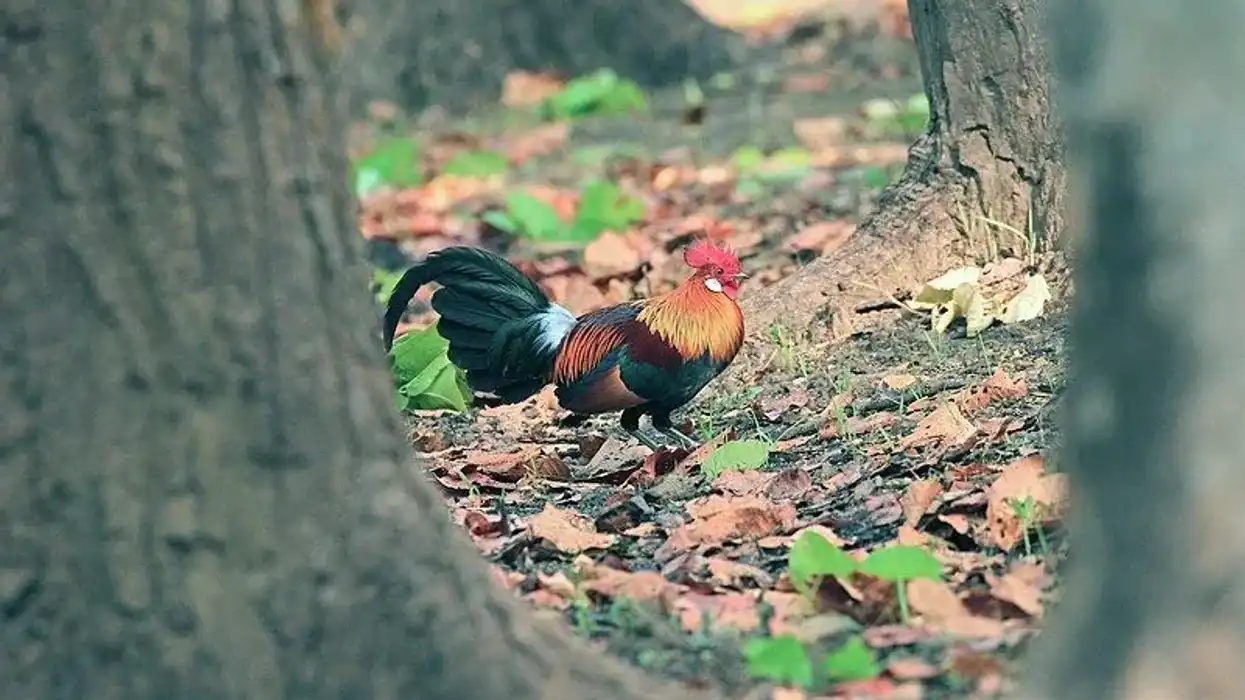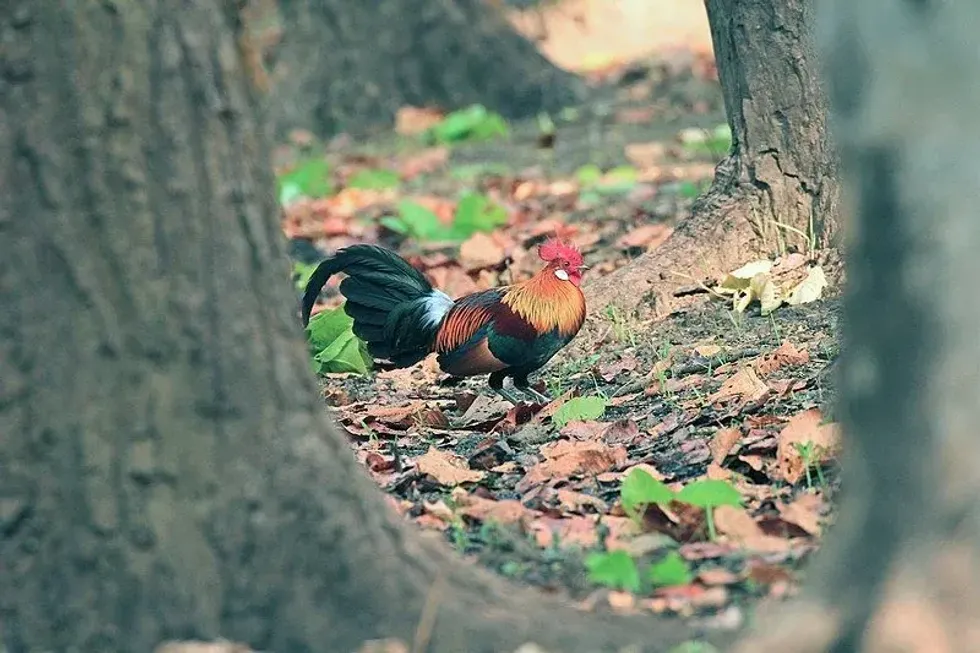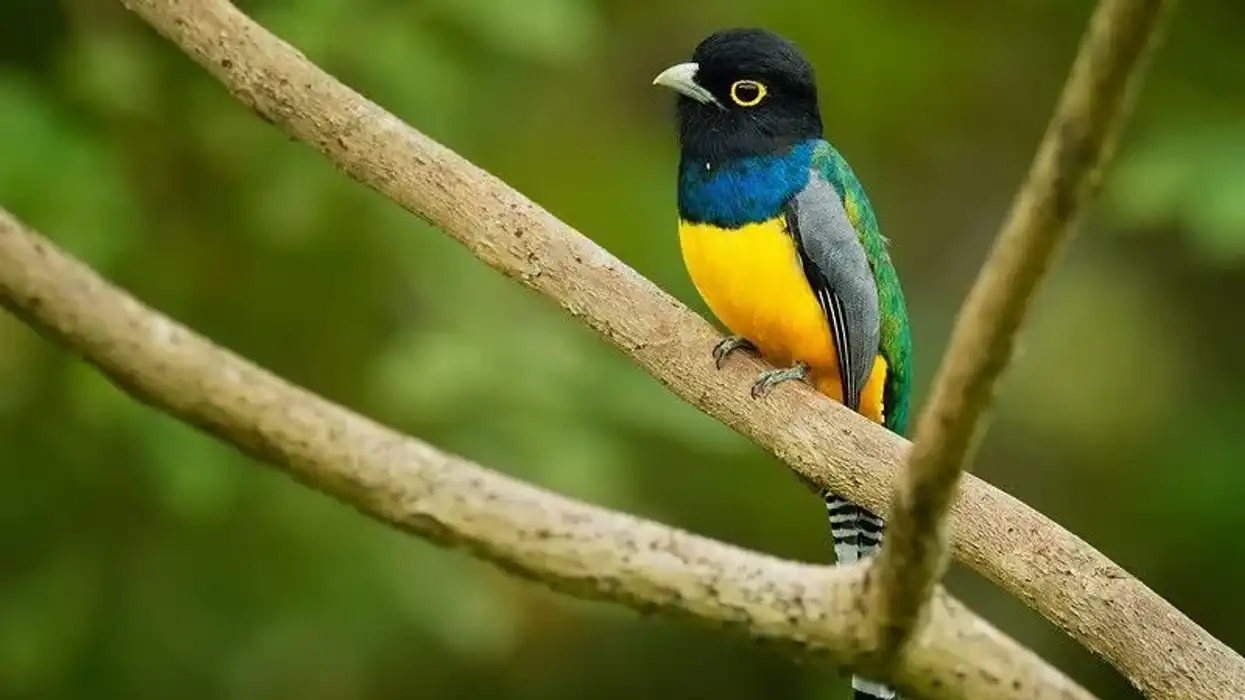Fun Red Junglefowl Facts For Kids
The red junglefowl is an ancestor of domestic chickens, that is, the Gallus domesticus. It is found in the wild in some regions of Southern Asia particularly in the lush green forests of India.
It is a terrestrial bird with colorful plumage. They may look similar yet the birds are not the same as our regular fowl.
If noticed minutely the differences can be noted! Though similar to the call of the male of a chicken, the call of a wild gallus ends abruptly on the last note.
The domestic chickens are direct descendants of this bird with certain introgression from the grey junglefowl. In some cases, a yellow skin phenotype has been observed in the chicken as a result of this.
Like reading this? Let's cock a doodle doo further!
If you like reading this content, you may also enjoy reading fun facts about bobwhite quails and ferruginous hawks.
Red Junglefowl Interesting Facts
What type of animal is red junglefowl?
Wild red junglefowl is a tropical bird that belongs to the order Galliformes and the family Phasianidae.
What class of animal does red junglefowl belong to?
Red junglefowl belongs to the class of Aves (birds).
How many red junglefowl are there in the world?
Red junglefowl birds live in considerable numbers in wild in places like Southern China and India. However, in places like Singapore, they have become endangered, because of red junglefowl hunting by the poachers.
As these birds tend to dwell on the ground, they serve as easy targets for many unscrupulous poachers. Further, the wild red junglefowl population is dwindling because of interbreeding. The red junglefowl hybrid is obtained as a result of interbreeding with the other wild species or with domestic chickens.
Where does a red junglefowl live?
The gallus red junglefowl lives in thick secondary forests, scrubs, mangroves, woodlands, and grasslands.
What is a red junglefowl's habitat?
The Gallus gallus is found extensively across South Asia and Southeast Asia especially in the jungles of India. It is here that they are known to have belonged originally. The location of the red junglefowl range from the western Himalayas in the north of India to Southern China.
These birds are also found in the Caribbean Islands in the Pacific and even in Australia. With the passage of time, they were taken across oceans by various settlers. They are also found in palm oil estates and ripe fruit plantations.
Who do red junglefowl live with?
The red junglefowl domestic vs wild behavior differs greatly. The red junglefowl is shy as compared to the domestic chicken. Domestic chickens adapt well around human families.
On the contrary, the wild gallus is not friendly enough with humans and prefers to reside in solitude. The wild gallus is usually found in family groups of not more than 20 birds. The family system is such that there is one dominant male along with a few females and juveniles in the same family.
Sometimes a few subordinate males can also be a part of the group. The males are highly territorial and tend to defend their territory against competing males.
This kind of territorial behavior is especially visible when the females are around. Males tend to reside in solitude as well. These birds are non-migratory in nature.
How long does a red junglefowl live?
The average lifespan of this ancestor of the domestic chicken in captivity is 30 years and in the wild, it is around 12 to 14 years.
How do they reproduce?
The male red junglefowl announces that it wishes to mate in the mating season by crowing, that is, a cock-a-doodle-doo call! However, in a group only the dominant male crows.
In the breeding season, as a male bird forages for food successfully, he tries to communicate it to the female bird through cluck-like calls and different kinds of motion like bobbing and twitching of the head and neck. This kind of display is called tidbitting.
Sometimes the birds are coaxed as well. As the females pick the food up from the ground or from the beak of the males, the males are content as it starts the mating ritual.
The laying season for red junglefowl begins under the rays of the summer sun, in the months of spring and summer.
The red junglefowl hen lays one egg per day in the breeding season. It takes 21 days for the chick to fully develop from the embryo, until then it feeds on the yolk that surrounds it.
Generally, the red junglefowl lays one-two clutches every year, and each clutch has four-six eggs, on average. The chick's body receives nutrients from the umbilicus.
In the first week, the heart and blood vessels are formed and they start working, followed by the head and all other organs. The sexual organs are formed later that week and sexual maturity is reached within five months.
This happens faster for the male chick than the female one. In the second week, the skeletal structure is formed using the calcium from the surrounding eggshell.
It can take up to twenty hours for a chick to hatch, breaking the thin shell of the egg.
Slowly the chicks become fully feathered and later at around nine weeks the wings pertaining to adulthood appear. After three more weeks the mother chases the chicks out from the family and they are left to fend for themselves.
It is interesting to note that the chicks may form groups by interacting with other chicks or they may join an existing group of birds and adapt to their hierarchy. No wonder these birds are of so much interest to humans.
It is this social behavior that definitely contributes to the cause. An analysis of this has been carried out by researchers all over the world.
What is their conservation status?
According to the International Union for the Conservation of Nature (IUCN), the status of the red jungle fowl falls under the Least Concern category.
However, even though they fall under the Least Concern category, the population for this gallus is decreasing with their numbers concentrated only in some parts of the world. In Singapore, the G. gallus is considered endangered and is found on the Endangered list in the Red Data Book, and conservation of the species is being looked into.
These birds are being protected in the national parks, wildlife sanctuaries, and biosphere reserves along with other birds and animals in many places.
Red Junglefowl Fun Facts
What do red junglefowl look like?

The Gallus gallus is a beautiful bird with brown, orange, gold, red, dark maroon plumage with a hint of metallic gray and green. Some olive and white feathers are also visible.
The distinguishing feature of this gallus is its grayish feet and two white ear-shaped patches on either side of the head. The eclipse plumage is an interesting fact about this bird.
In the female bird, it is not particularly visible but she does molt. However, in the male one, the eclipse showcases a long black feather across the middle of his back and as slender reddish-orange plumes on his remaining hide.
This plumage becomes visible in the months of June to October. There are 14 tail feathers in the male of this species. The wingspan varies from 15-20 in (38-51 cm).
The tail feathers of the males of this gallus have a white patch and there is a red comb on their heads. The female bird has a smaller comb and wattles than the male.
The physical features of the female are better adapted for camouflage than that of the males. The red and the Ceylon junglefowl are closely related.
How cute are they?
A chick of the red junglefowl is definitely cute! However, an adult red junglefowl can be described as curious, skittish, or feral rather than being called cute.
How do they communicate?
In the world of the red junglefowl, there is a distinct pecking order. The males of the red junglefowl peck in a different way than the females.
The complexity of the calls is noticeable amongst these birds. The alarm calls for the different kinds of predators vary.
The red junglefowl cackle is different for the red junglefowl predators on the ground and for the predators in the air. Calls are also used by dominant males to warn the potential competitors in the area. They use it to establish themselves firmly in their respective territories.
Subordinate males of the species are required to bow down in front of the dominant male who stands tall. What interesting ways of communication exist amongst these birds!
How big is a red junglefowl?
The red junglefowl size varies with their sex. The male red junglefowl at 30 in (76cm) is bigger as compared to the female red junglefowl i.e. 17 in (43.1 cm). The birds also differ in size from their subspecies of the domestic chicken. The wild breed is smaller in size which is perfect for camouflaging in their natural habitat!
How fast can a red junglefowl move?
The red junglefowl unlike the domestic chicken can fly for short distances. The gallus prefers to roost in the branches of a tree to avoid predators on the ground. The red junglefowl can run at a moderate speed if the need arises.
How much does a red junglefowl weigh?
The red junglefowl weight varies with the sex of the birds. The feral males weigh around 3.25 lb (1.5 kg) whereas the feral females weigh around 2.25 lb (1 kg).
What are the male and female names of the species?
Usually, a young male red junglefowl is called a cock or cockerel and the adult female red junglefowl is called a hen.
What would you call a baby red junglefowl?
Usually a baby red junglefowl, that is, G. gallus, is called a chick.
What do they eat?
The red junglefowl diet includes grains, leaves, tubers, roots, bamboo, small insects, snakes, snails, arthropods, and various other vertebrates and invertebrates like small lizards. They are usually attracted to places with ripe fruits and grains.
They have a tendency to forage on the ground, however, sometimes they do forage in trees for ripe fruit. The adult red junglefowl, Gallus gallus prefers plant-based food to arthropods and insects but the chicks munch on worms, insects, and sometimes plant-based food.
Are they aggressive?
The red junglefowl can turn aggressive when attacked or provoked. Cockfights can turn aggressive in the mating season. Also, the young males who are more aggressive tend to mate more and with the maximum number of females.
Would they make a good pet?
The red junglefowl, Gallus gallus, is rather feral, however, domestication of the species has been carried out by humans. The wild gallus prefers to be left alone and is very skittish in nature.
Did you know...
In Hawaii, the red junglefowl bird is termed as moa, and the Polynesian royalty used to wear cloaks made of red junglefowl feathers.
The eggs of this species are pale, cream, or light brown in color.
In the wild, these birds may follow monogamy. However, when interbreeding they are often polygamous.
The females of this wild ancestor of the domestic chicken lay one to two clutches of eggs annually. The red junglefowl female habitat comprises nests at elevated heights or in covered areas in the ground surrounded by grasses and twigs. The hen alone looks after the chicks and the eggs.
Some humans prefer their chickens wild and rear them in their backyard.
On a regular basis, these feral chickens bathe in the dust to maintain the oil balance in their feathers. The dust falls off automatically after absorbing the oil.
When were the earliest red junglefowl domesticated?
The domestication of these birds took place roughly around 8,000 years ago. Some researchers are of the view that it might have happened even earlier. Others believe that they have been domesticated around 3200 BC. Domestication was carried out mainly for meat and red junglefowl eggs. They were also used in cock-fighting and in religious ceremonies.
What is unique about the red junglefowl?
The red junglefowl native to Hawaii is the first introduced bird in the US State. Hundreds of years ago the Polynesian settlers introduced the South Asian red junglefowl in Hawaii. Since then they have been valued for their meat and eggs across the area.
Here at Kidadl, we have carefully created lots of interesting family-friendly animal facts for everyone to discover! Learn more about some other birds from our scarlet macaw facts and metallic starling facts pages.
You can even occupy yourself at home by coloring in one of our free printable red junglefowl coloring pages.
We Want Your Photos!
More for You
See All
Bachelor of Arts specializing in Journalism and Mass Communication, Postgraduate Diploma in Sports Management

Moumita DuttaBachelor of Arts specializing in Journalism and Mass Communication, Postgraduate Diploma in Sports Management
A content writer and editor with a passion for sports, Moumita has honed her skills in producing compelling match reports and stories about sporting heroes. She holds a degree in Journalism and Mass Communication from the Indian Institute of Social Welfare and Business Management, Calcutta University, alongside a postgraduate diploma in Sports Management.
Disclaimer
1) Kidadl is independent and to make our service free to you the reader we are supported by advertising. We hope you love our recommendations for products and services! What we suggest is selected independently by the Kidadl team. If you purchase using the Buy Now button we may earn a small commission. This does not influence our choices. Prices are correct and items are available at the time the article was published but we cannot guarantee that on the time of reading. Please note that Kidadl is a participant in the Amazon Services LLC Associates Program, an affiliate advertising program designed to provide a means for sites to earn advertising fees by advertising and linking to Amazon. We also link to other websites, but are not responsible for their content.
2) At Kidadl, we strive to recommend the very best activities and events. We will always aim to give you accurate information at the date of publication - however, information does change, so it’s important you do your own research, double-check and make the decision that is right for your family. We recognise that not all activities and ideas are appropriate for all children and families or in all circumstances. Our recommended activities are based on age but these are a guide. We recommend that these ideas are used as inspiration, that ideas are undertaken with appropriate adult supervision, and that each adult uses their own discretion and knowledge of their children to consider the safety and suitability. Kidadl cannot accept liability for the execution of these ideas, and parental supervision is advised at all times, as safety is paramount. Anyone using the information provided by Kidadl does so at their own risk and we can not accept liability if things go wrong.
3) Because we are an educational resource, we have quotes and facts about a range of historical and modern figures. We do not endorse the actions of or rhetoric of all the people included in these collections, but we think they are important for growing minds to learn about under the guidance of parents or guardians.







